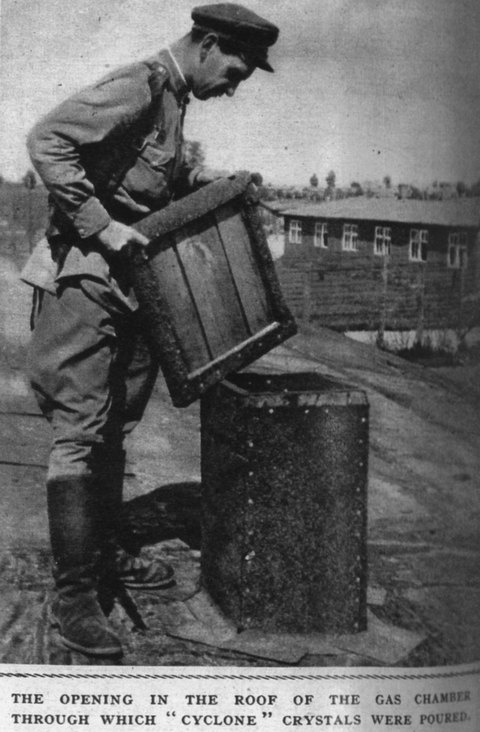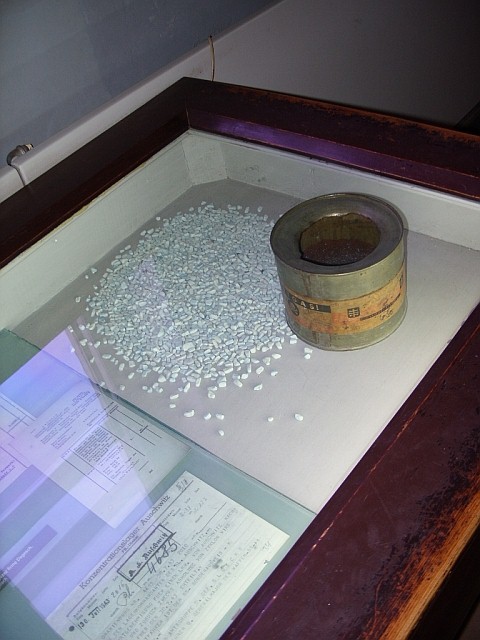Unanswered Questions Regarding the Physical Evidence at the Majdanek Concentration Camp (Poland)
from: 'Forty-Six Important Unanswered Questions Regarding the Nazi Gas Chambers'
by David Cole
https://codoh.com/library/document/987/?lang=en 
Gas chamber 1 has two doors, both of which open INTO the gas chamber room. How can a homicidal gas chamber have two doors which open IN? Wouldn't the bodies be pressed up against the doors, as described numerous times by eyewitnesses?

The main door into the gas chamber 1 has no locks. It can be opened from either the inside or the outside. There are no holes or fittings where a lock might have been. What stopped the inmates from opening this door?

Gas chamber 1 has a plate glass window in it. There are no holes or fittings around the window where bars or any other kind of cover might once have been. Since the plaster around the window is covered with blue stains, we know that it is the plaster that existed during the time Zyklon B gas was used in this room. If there WERE bars or any other type of cover attached to this window, why are there no traces? What would have stopped the inmates from trying to climb out the window, or breaking the window and causing a gas leak?

There is a room INSIDE gas chamber 1. Why would there be a separate room INSIDE a gas chamber? Doesn't this room indicate that gas chamber 1 was used for something OTHER than killing people?

Gas chambers 2 and 3 are designed backwards. Chamber 2 has a Zyklon B induction hole in the ceiling, but no Zyklon B traces or blue stains. Chamber 3 has heavy, floor-to-ceiling Zyklon B traces and blue stains, but no Zyklon B induction hole. And, like the roof of Krema 2 at Auschwitz, the ceiling shows no sign of a hole having ever been there. Why would chamber 2 have a Zyklon B induction hole and no traces, and chamber 3 plenty of traces but no hole?

The ceilings in chambers 2 and 4 are low enough so that the Zyklon B induction holes could have been blocked by the victims. What would have stopped the inmates from blocking the holes?
(33) The doors to chambers 2,3 and 4 are built to latch from the outside AND the inside. The latches can be opened from either side. Does this suggest that the rooms were used for something other than killing people?

Getting back to the issue of hemispherical grids covering the peepholes, it is said that the point of these grids was to prevent the inmates from breaking the glass of the peepholes and causing a gas leak. Yet the hemispherical grids attached to the peepholes on the doors of chambers 2, 3 and 4 are attached on the OUTSIDE of the doors. These grids wouldn't prevent someone INSIDE the room from breaking the glass...but they WOULD prevent someone OUTSIDE the room from doing so. Why are the grids not on the inside? Does this contradict with the statements by Pressac and the eyewitnesses regarding the need for grids in a homicidal gas chamber?

The Majdanek camp is built on a hill. At the top of the hill is the camp crematorium. At the opposite end of the camp, at the bottom of the hill, is the "Bath and Disinfection" complex, which houses the gas chambers. From the Nazi's point of view, what was the wisdom in putting the gas chambers at the opposite end of the camp from the ovens, and at the bottom of the hill (after each gassing, the dead bodies would have to have been dragged up the hill, the length of the entire camp, to the ovens)?

As the Nazis were preparing to abandon the Majdanek camp, they destroyed the crematorium building. Why were the gas chambers not similarly destroyed? Why would the Nazis leave their weapons of mass murder intact for the world to see? How hard would it have been for the Nazis to destroy the gas chambers, just like they did the crematorium building? At least, shouldn't the Nazis have filled in the Zyklon B induction holes, which serve as direct proofs of homicidal gassings? Either way, the destruction of the crematorium is clear proof that the Nazis had both the time and the ability to demolish buildings in the camp if they wanted to. Why were the gas chambers not demolished?

In his book "Auschwitz: Technique and Operation of the Gas Chambers", Jean-Claude Pressac publishes a photo of the Majdanek gas chambers, with the caption "Photograph taken at the Majdanek concentration camp in June 1979, showing one of the disinfestation gas chambers thought to be a homicidal gas chamber." On page 555, he also has this to say about the Majdanek gas chambers: "I am sorry to say, and I am not the only one in the West, that the Majdanek homicidal and/or delousing gas chambers are still waiting for a true historian, which is mildly upsetting in view of the fact that the camp fell into the hands of the Russians intact in 1944." Do these comments suggest that the gas chambers at Majdanek may in fact have been disinfestation gas chambers? At least, don't these comments suggest that there has not yet been a thorough investigation into the purpose of these rooms? **

To sum up the Majdanek gas chamber issue: If we take Pressac's comments and then factor in the doors that don't lock, the doors that open INTO the gas chamber, the doors with latches that can be manipulated from both the outside AND the inside, the window in gas chamber 1, the room inside gas chamber 1, the lack of any Zyklon B induction hole in gas chamber 3, the lack of any Zyklon B traces in gas chamber 2 (which DOES have a "Zyklon B induction hole"), the heavy blue stains on the OUTSIDE of the building, and the location of the building, at the bottom of a hill, at the opposite end of the camp from the crematorium, is it reasonable to suggest that these rooms were delousing chambers?
** In what can only be considered an unfortunate example of how major disputes between Holocaust historians are shielded from the public, the same room Pressac describes in his book as a "disinfestation gas chamber" is featured in the book "The World Must Know," the official book of the U.S. Holocaust Memorial Museum in Washington D.C., written by Museum director Dr. Michael Berenbaum.
In that book, Berenbaum describes the room as a HOMICIDAL gas chamber and, what's more, a CASTING of this room was made for display AT THE MUSEUM, as PROOF of the homicidal gas chambers! Thus, in both Berenbaum's book AND in the Museum itself, the ONLY material proof given of homicidal gassings is THIS ROOM, a room Pressac staunchly believes to be a disinfestation gas chamber (in fact, in his Auschwitz book, Pressac actually RIDICULES those who say that this Majdanek room is proof of homicidal gassings, and criticizes everyone from the man who prosecuted Faurisson in France to the Majdanek State Museum personnel for perpetuating a fraud).
But does anyone give a damn that the general public, all the millions, might be receiving fraudulent information? Some might suggest that disputes such as these should be kept private so as not to shake the public's confidence in Holocaust history, or in the Holocaust historians. But don't you think we have a RESPONSIBILITY not to knowingly feed the public falsehoods or unproven claims disguised as unquestioned facts? Don't you think we have a responsibility to be honest about our research? If not, what makes us any different from the "historians" of the Soviet Union, or Hitler's Germany, who knowingly tailored their research to produce a politically expedient conclusion? When the ends begin justifying the means, watch integrity go flying out the window.
As bad as the public misinformation about Majdanek is, the Stalin-esque purging of Pressac's "Auschwitz; Technique and Operation of the Gas Chambers" from the official record is worse. This master-work of historiography, once loudly heralded in the press (see enclosed clippings), is NOW nowhere to be found when references to Pressac are made. A recent article in "Publishers Weekly," detailing a forthcoming U.S. Holocaust Museum book containing 29 original essays from Holocaust scholars including Berenbaum and Pressac, not only neglects to mention Pressac's gas chamber book, but seems to suggest that Pressac's conversion from revisionist to gas chamber believer came only recently, as he was researching his just-published "slim volume" about the Auschwitz crematorium.
The entire period of the 1980's, which Pressac spent researching his gas chamber book after his "conversion", is omitted.
Yet scholars around the world continue to use Pressac's gas chamber book (if they're lucky enough to have one of the few copies), mainly because, even if one disagrees with Pressac's conclusions, his book is STILL the best (and the only) single source for the blueprints, construction slips, alteration plans, and inter-office communiques regarding the Auschwitz "gas chambers".
Neither side in this debate agrees entirely with Pressac...but for the gas chamber supporters, his book is an embarrassment because it IS so thorough. It is the most thorough work yet produced about the gas chambers, yet Pressac cannot find that elusive objective proof of gassings. So now, apparently, the historians have just decided to pretend the book doesn't exist. I've always referred to the Pressac gas chamber book as the most popular book that never existed!




